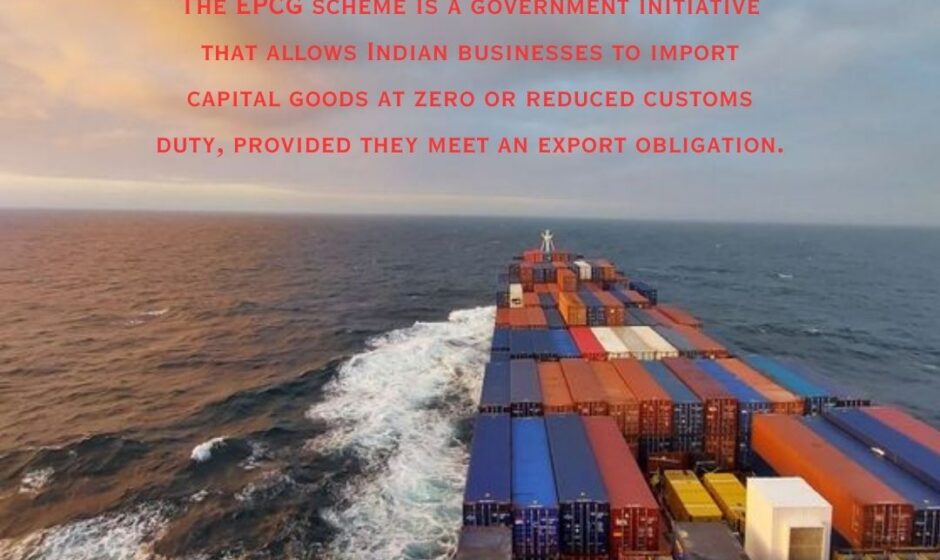The EPCG scheme is a key initiative under the Indian Foreign Trade Policy, aimed at encouraging the import of capital goods for the production of high-quality goods and services for export. Introduced by the Government of India, the EPCG scheme allows businesses to import capital goods at reduced or zero customs duty, provided that the importer fulfills a specific export obligation within a given period. The main goal of the scheme is to promote the modernization and technological advancement of industries, making Indian exports globally competitive companies must export goods or services worth six times the saved duty within six years. the EPCG scheme is a government initiative that allows Indian businesses to import capital goods at zero or reduced customs duty, provided they meet an export obligation.
Key Features of the EPCG Scheme
- Concessional Customs Duty: One of the most attractive features of the EPCG scheme is the ability to import capital goods at concessional customs duty, often at 0% or significantly lower rates than standard duties.
- Export Obligation: The importer availing of the EPCG scheme must commit to an export obligation, which is typically six times the duty saved on the imported capital goods. This obligation must be fulfilled within six years from the date of the EPCG authorization.
- Capital Goods Coverage: The scheme covers a wide range of capital goods, including plant and machinery, equipment, and other items that are used in the production, pre-production, and post-production processes.
- Domestic Sourcing Option: Apart from imports, the scheme also allows for sourcing capital goods from indigenous manufacturers, promoting the use of domestic products while still enjoying the benefits of the EPCG scheme.
- Applicable to Multiple Sectors: The scheme is available to a wide range of sectors, including manufacturers and service providers involved in export activities, such as IT, healthcare, tourism, and engineering industries.
Benefits of the EPCG Scheme
- Cost Savings: By allowing the import of capital goods at reduced customs duties, the scheme significantly lowers the cost of upgrading machinery and technology, making it easier for businesses to enhance production efficiency.
- Boost to Exports: The scheme encourages businesses to focus on exports, as meeting the export obligation is key to enjoying the duty concessions. This helps in increasing India’s share in the global market.
- Encourages Technological Advancement: By facilitating the import of state-of-the-art machinery, the EPCG scheme promotes technological advancement within industries, leading to higher-quality products and improved production methods.
- Promotes Employment: With increased exports and industrial growth, businesses can expand their operations, leading to the creation of more jobs and contributing to economic development.
Eligibility Criteria for the EPCG Scheme
- Manufacturers and Service Providers: The EPCG scheme is available to both manufacturers and service providers who are involved in the export of goods or services.
- Direct and Indirect Exporters: Both direct exporters (who export goods themselves) and indirect exporters (who supply goods to exporters) can avail of the benefits under this scheme.
- Service Exporters: Service providers involved in sectors like IT, healthcare, and tourism, who export services, are also eligible for the EPCG scheme.
Procedure to Avail the EPCG Scheme
To benefit from the EPCG scheme, businesses need to follow these steps:
- Application Submission: The applicant must submit an application to the Directorate General of Foreign Trade (DGFT) with the required documentation, including details of the capital goods to be imported and the projected export obligation.
- Issuance of EPCG Authorization: Upon verification, the DGFT issues the EPCG authorization, which allows the import of capital goods at concessional duties.
- Fulfillment of Export Obligation: The business must meet the export obligation over the next six years, based on the duty saved. This is monitored by the DGFT.
Compliance and Penalties
If the business fails to meet the export obligation within the stipulated time frame, it may face penalties, including the repayment of the saved duty along with interest. Therefore, maintaining proper records of imports and exports and regular reporting to the DGFT is crucial for compliance with the EPCG scheme.
Conclusion
The EPCG scheme is a significant initiative that promotes industrial growth and strengthens India’s export sector by enabling businesses to upgrade their technologies at reduced costs. Through reduced customs duties and export incentives, the scheme helps manufacturers and service providers improve production capabilities, reduce costs, and boost export competitiveness on a global scale. However, businesses must carefully adhere to the compliance requirements to fully benefit from the scheme this scheme is open to both manufacturers and service providers, promoting technological advancements and supporting the growth of India’s export sector while boosting foreign exchange earnings.



